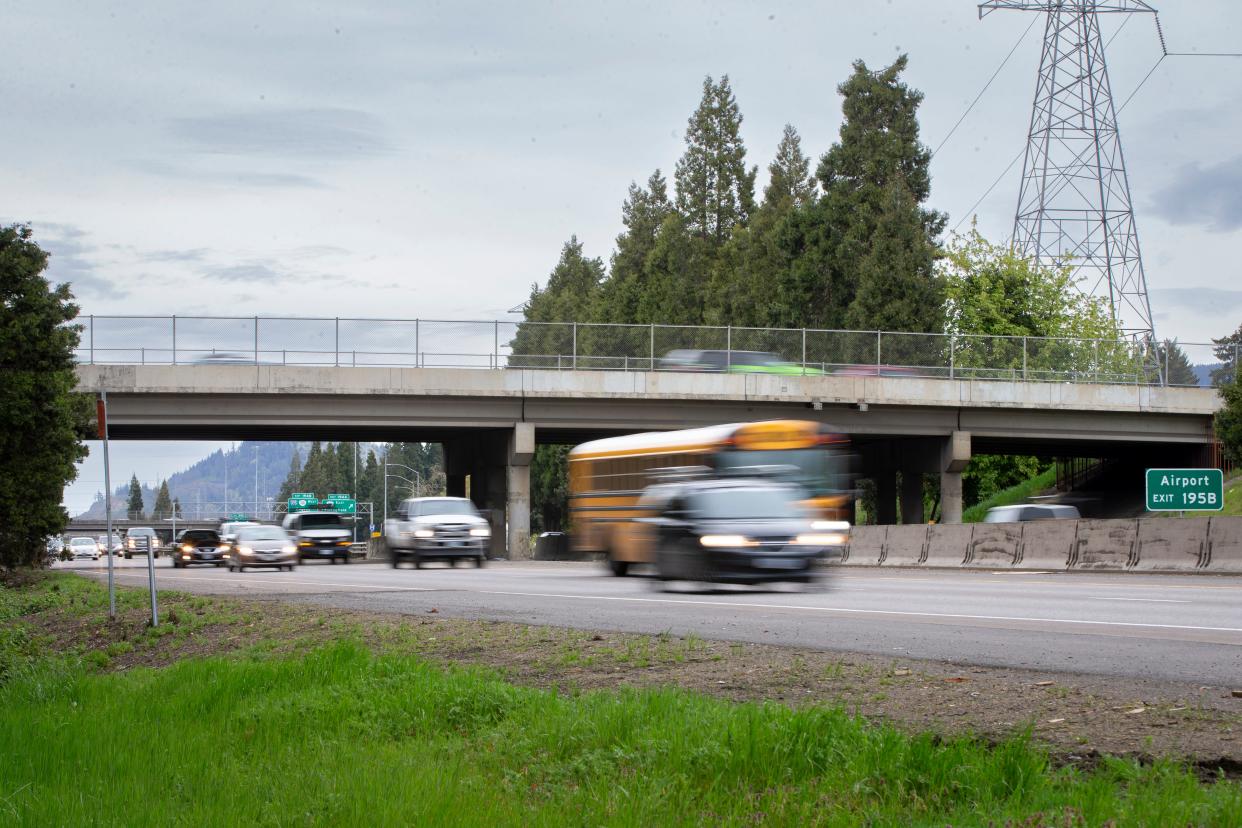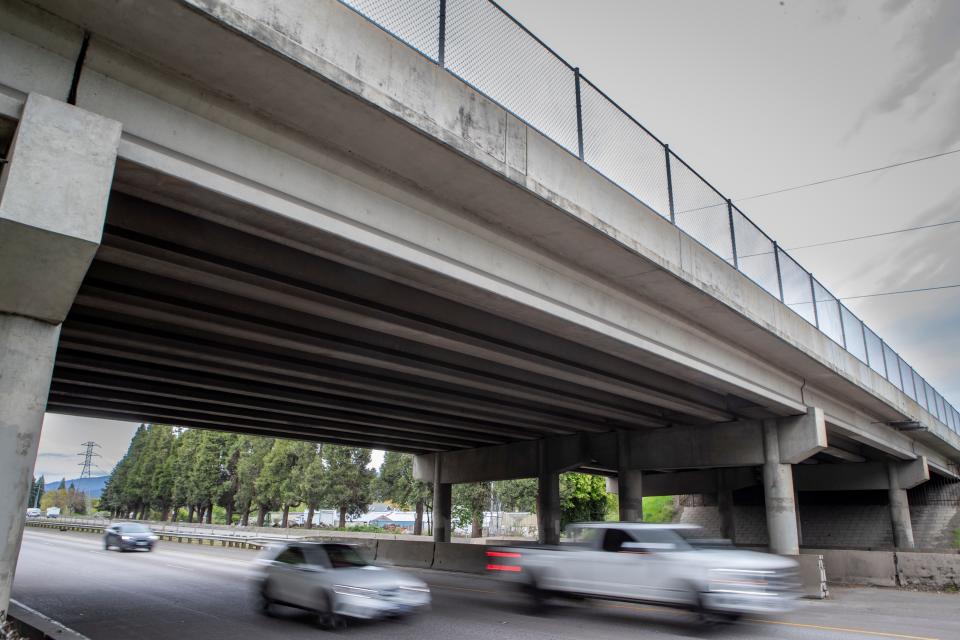More Oregon bridges rated 'poor' condition as funding gap widens, according to report

Oregon's iconic bridges, like those crossing the Willamette River in Eugene, are showing their age, and a new state report suggests a lot of work must be done to keep them standing strong.
The Oregon Department of Transportation (ODOT) recently released its 2023 Bridge Condition Report and Tunnel Data and it revealed that a number of bridges across the state, including some in Lane County, are in need of maintenance or replacement in the not-so-distant future.
ODOT bridge system management
The report states that ODOT manages 2,773 bridges and averages about three bridge replacements per year. With adequate levels of funding, “approximately 27 state highway bridges could be replaced annually which is consistent with a 100-year service life,” according to the report. Federal law requires bridge conditions to be assessed at least every two years. Bridges in “poor” or “very poor” condition are assessed by ODOT more frequently.
Bridge conditions are measured by both Oregon’s Bridge Key Performance Measures and National Bridge Performance Measures to assign a condition level to bridges. Conditions range from “very good,” “good,” “fair,” “poor” and “very poor” to describe structural deficiencies. The report states that 44 bridges in the system are considered to be in “poor” condition due to structural deficiencies and notes that overall bridge conditions are declining due to aging structures.
ODOT is only able to fund the replacement of three bridges per year. According to the report, this slow pace means that “ODOT continues to lose ground in the effort to manage the system,” as more bridges meet the end of their functional lifespan each year, about 100 years. The agency will need to maintain or replace about 40% of the bridges built between 1951 and 1970. Oregon’s “good” bridge conditions have been trending down since 2016 as bridge structures continue to age.
'Poor' condition doesn't mean Oregon bridges are unsafe, ODOT says
Many bridges across the state are designated as being in "poor" condition, but Mindy McCartt, ODOT’s public information officer for Lincoln, South Polk, Linn, Benton and Lane counties, said “poor” does not equate to being unsafe or unusable.
“Poor doesn't mean unsafe, it just means it's older and needs more repairs,” McCartt said.
“It helps us focus our attention because we monitor 2,773 that ODOT manages across the state. That’s a lot of bridges so when you get into those conditions, it helps focus our attention and prioritize our work and our funding.”
McCartt said much of the funding used for bridge repairs comes from maintenance and operations funding provided by the Legislature and generated through the state’s gas tax. This funding, she said, has been declining.
“There are more fuel-economic vehicles, more people using public transportation or finding other avenues than driving cars,” McCartt said.
“As those gas taxes decline, so does the money that we have to spend on maintenance and operations.”
Despite limited funding, McCartt said ODOT continues to plan and prepare for bridge repairs, replacements and quick responses to issues as they arise, particularly in relation to recent events like the Francis Scott Key bridge collapse caused by a cargo ship hitting the structure and the anticipated Cascadia Subduction Zone earthquake.
“These types of catastrophes that could happen, while ODOT has hazard plans and most state agencies have emergency plans, each incident is really unique and the state’s response resources are based on the need of those unique situations,” McCartt said.
Lane County Emergency Management as a conduit
Lane County manages 429 bridges with a handful of them in "poor" condition.
Tiffany Brown, emergency manager for Lane County, said the county discusses bridges and lifeline routes, a tiered system of routes assessed for emergency responders to react following a disaster, with specific respect to the Cascadia Subduction Zone earthquake and tsunami hazard.
“We’ve known about the vulnerability of Oregon bridges for a number of years, but that’s really the catalyst for the conversation in the last 10 years is having that potential event in front of us that really illustrates the problem,” Brown said.
Brown said the information from ODOT’s Bridge Condition report allows the county to localize the data provided to help people better understand it and to prepare responses for events. She said there is a regional saying: “If you’re prepared for Cascadia, you’re prepared for anything.”
“I think the biggest issue we have right now is with the seismic fragility and vulnerability of our bridges,” Brown said.
Devon Ashbridge, Lane County’s public information officer, said preparing for “all hazards” helps not only individuals and their families but the rest of the community should an emergency or disaster occur. The adage to “Get Two-Weeks Ready” can help prepare residents for a range of occurrences, from floods to ice storms to earthquakes to chemical spills and other hazards.
“This ‘all-hazards’ approach and using Cascadia sort of as the golden standard serves us across many, if not all of the hazards we face, both natural and man-made here in our area,” Ashbridge said.
Eugene’s bridges
The city of Eugene manages over 110 pedestrian and vehicular bridges and contracts with engineering firms that staff bridge inspectors to complete inspections every other year, according to Marion Suitor Barnes, the public affairs manager for Eugene’s Public Works department.
Barnes said some factors that contribute to the city’s decisions on what bridge repairs to prioritize include bridge condition, proximity to emergency services and schools, location, carrying capacity, alternative access routes and additional concerns that tie into the choices made. Funding for these repairs and updates comes from sources such as federal grants, state funding and local bonds. Funding is an element of this decision-making that can limit the ability to complete needed work.
“It’s important to note that we will always have insufficient funding to perform all necessary work. Obviously, because the scale of bridge work is enormously expensive, funding does not exist to address all the needs,” Barnes said.
“We can usually only get funding for one or two projects per year, which makes it slow to get through the backlog.”

Barnes said the routine inspection process conducted by the city ensures that they are aware of structural issues long before they become problematic and reach a critical status. She said that structural deficiencies are different from seismic vulnerabilities, where a bridge could be structurally sound but due to code enforced at the time of bridge construction, a structure may be unable to withstand a seismic event.
Much like how representatives for ODOT and Lane County affirm that emergency management takes an "all-hands-on-deck" approach, Barnes said the city of Eugene accounts for resource accessibility in the case of bridges failing during an earthquake event.
“We routinely discuss the risk to community safety posed by a Cascadia event, especially now that Eugene residents are separated by bridges from the closest hospital,” Barnes said, referring to the recent closure of the PeaceHealth Sacred Heart Medical Center University District hospital.
This summer, folks in Eugene can expect to see the Amazon Creek and Bailey Hill Road Bridge receive a seismic retrofit. Another seismic retrofit is planned to begin in early fall for the Chambers Street Bridge near the intersection of Roosevelt Boulevard.
Power in preparedness
On top of being two-weeks ready as an individual, Ashbridge said being prepared for an emergency also helps local first responders, who are community members affected by disaster, too. She said when the number of first responders in Lane County is compared to the population they are expected to serve, there are not a lot of first responders. Response efforts can be impacted when first responders themselves are also affected by events necessitating their work.
“There is power in that personal preparedness and being ready to do everything that you can to keep yourself and your family safe at home,” Ashbridge said.
“That doesn’t lessen the effort that Lane County and other responding agencies would put forward to help people, that’s what we’re here for, but we also want people to have a realistic expectation of what is possible in this community.”
Hannarose McGuinness is The Register-Guard’s growth and development reporter. Contact her at 541-844-9859 or hmcguinness@registerguard.com
This article originally appeared on Register-Guard: Oregon bridge conditions worsen as funding gap widens: Report

